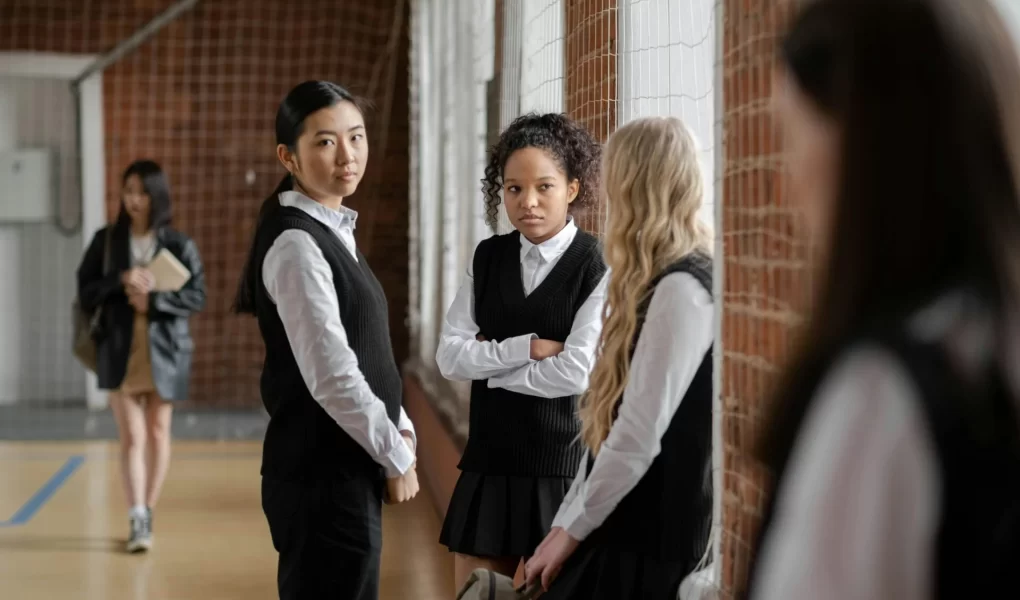When I was in school, I remember the teachers often talked about peer pressure. They would warn us about the dangers of giving in and share what activities we should avoid, even if our friends were doing them.
Our parents also addressed this, though they rarely called it “peer pressure.” Many of us remember the familiar question: “If your friends jumped off a cliff or a bridge, would you jump too?” Back then, these conversations might have felt trivial or even frustrating. But looking back now, it’s clear how valuable they were in guiding us to make better choices and stay true to who we are.
Now, it’s our turn to guide our children and help them prepare for the peer pressure they’ll inevitably face. Whether it’s resisting activities that may not be in their best interest or staying grounded in their values, our role is vital. To do this, we need to understand peer pressure—its types, how to equip our kids with the tools to confidently say no, and how to explain it all in ways that they’ll understand.
What is peer pressure?
Merriam-Webster defines peer pressure as “a feeling that one must do the same things as other people of one’s age and social group in order to be liked or respected by them” (“Peer pressure.” Merriam-Webster.com Dictionary, Merriam-Webster, https://www.merriamwebster.com/dictionary/peer%20pressure. Accessed 2 Apr. 2025.)
Anyone can experience peer pressure, but young people (or children) are more susceptible to it. This is because it’s natural to want to fit in and form close bonds with friends during a person’s formative years. This desire often drives them to participate in certain activities or adopt particular behaviors to emulate others. The ultimate goal is to fit in and be liked.
Types of peer pressure
There are 4 types of peer pressure:
- Direct peer pressure
- Indirect peer pressure
- Positive peer pressure
- Negative peer pressure
Let’s explore what each of them are.

Direct peer pressure
Direct peer pressure, or active peer pressure, happens when a person or group directly and explicitly encourages others to participate in a certain activity or action. Sometimes, even though this may be presented as a request or perhaps a dare, it’s very clear that not doing it would result in the person being excluded from the group. Therefore, their participation is not optional.
This type of peer pressure is divided into 2 subtypes: Spoken and unspoken.
Spoken peer pressure is when a peer directly asks another to engage in an activity that they may not be comfortable with. It may look like a peer asking another to take a puff of their vape.
Unspoken peer pressure is when peers make no requests, however, they are actively engaging in a certain activity. The onlooker may feel pressured to join in order to fit in with the others. A common example would be friends jumping over a fence onto private property to hang out without permission. While no one explicitly asks others to participate, the pressure to follow along can be strong.
Indirect peer pressure
Indirect peer pressure, or passive peer pressure, can be more subtle yet equally impactful, as it doesn’t involve direct encouragement to participate. Nonetheless, it is still very much present. In this type of peer pressure, the onlooker may feel pressured to adopt a way of speaking, behavior, and even change the way they dress to fit in with the majority of their peers (“everyone’s doing it” mentality).
There is a set standard of what’s “cool” and acceptable. Not following the current trend of their peers may make them look like a misfit or “not cool like the other kids”.
Positive peer pressure
Not all peer pressure is bad. In positive peer pressure, the onlooker is encouraged to participate in good activities that foster growth and lead to positive outcomes. Peers in this situation promote good morals and support pursuits that help others improve in areas like academics, sports, and more.
This may look like discouraging a friend from skipping class or motivating them to join the track team.
In this type of peer pressure, their peers focus on helping each other excel and be a positive influence on their community.
Negative peer pressure
This is every parent’s nightmare. Negative peer pressure occurs when peers encourage someone to engage in harmful behaviors that can jeopardize their well-being or the well-being of others.
Some of these behaviors may include but are not limited to:
- Consumption of drugs and alcohol
- Smoking or vaping
- Bullying
- Self-harm
- Stealing and other criminal activities
- Ditching school
- Engaging in sexual acts
- Lying
- Sneaking out
- Joining gangs
The child will be actively encouraged to take part in activities that could have serious consequences. Their actions can have repercussions that could affect their future and even cost them their health, freedom, and so much more.
Why does peer pressure work?

It works because it’s human nature to want to belong and fit in with our peers. Feeling liked and accepted by those around us boosts our confidence.
For a growing child in their formative years, this need is crucial. They strive to impress their friends or, at the very least, be part of a group that shares their interests. Failing to achieve this can leave them feeling inferior to their peers or simply excluded and left out.
5 Tips to talk about peer pressure with your kids
1. Be informed
Your first step is to inform yourself of what peer pressure is and how it can affect your child. If you don’t understand it, you won’t be able to help your child or answer their questions.
2. Talk to your child
You can start the conversation by simply asking your child if they’ve ever heard the term “peer pressure” before and if they have ever discussed it at school. The conversation should be able to take off from there.
Try to get an idea of what kids at school are doing these days. You could ask questions like:
- What clothing styles are popular?
- How do their friends behave in class, and how do they talk to their teachers?
- Have they noticed kids smoking, vaping, using CBD gummies, or engaging in any type of drug use?
- Have they seen students taking another child’s school supplies, like pencil cases or notebooks, as a joke?
If you have a clear picture of what your child faces daily in school, you will know how to better equip them to face potential challenges.
3. Give them the tools to stand up to peer pressure
A prepared child is a confident child. When difficult situations arise, they will know what to say and how to handle them if you prepare them with the tools they’ll need to overcome peer pressure.
The best thing you can do is to help them prepare responses in advance that will empower them stand up for themselves, while at the same time maintaining their social status among their peers.
Here are some responses your child may want to try:
- I don’t think that’s cool
- I don’t smoke; I don’t like the smell of it
- I pass, don’t like the taste of “X” (This answer can be used to turn down alcohol or other substance)
- I don’t know how people like that, it’s just not for me
- That stuff doesn’t interest me
Answers like these give them control over their own choices. It relates to their friends that they aren’t partaking in an activity because THEY don’t like it. Not because their parents forbid them and they are scared. Remember, saying that their mom or dad doesn’t let them, mostly works when children are very little, but for preteens or teenagers, this can lead to mockery.
4. Let your child use you as the scapegoat

There are going to be times when your child might need to use you as the scapegoat in order to stay safe and not become the target of their peers.
Allow them to throw you under bus with their friends if necessary. For example, if a friend invites them to a sleepover with plans to sneak out in the middle of the night, give your child the green light to say that their parents are very strict and don’t allow sleepovers. You may come across as the “mean parent,” but that’s okay if it ensures your child’s safety.
Many parents have found success in having a secret code with their child that they can use if they need their parent’s help without catching the attention of their friends. It could be an emoji, a question, a word, etc. If your child feels uncomfortable or unsafe, they can text you the code. This can alert you that they want an out. You can then call them, claiming there’s an emergency or that they’re in trouble for not finishing a chore. Then, you can say you are going to go pick them up and that the party is over for them.
This strategy lets your child leave the situation safely, without raising suspicion among their peers. Yes, you might end up being the “bad guy” who ruins the fun, but it’s a small price to pay to ensure both their safety and their social standing remain intact.
5. Always leave the door open
Do you remember the recent trend of “we listen and we don’t judge?” Well, you need to make sure that your child feels safe to come to you without fearing you are going to judge them. This will make them more likely to seek your advice when they face challenges or don’t know what to do in a particular situation.
Having an open and honest communication with your children is essential for building a strong relationship and establishing a foundation that encourages them to be receptive to your guidance.
What should you do if you find out your child got in trouble for following their peers?
It can be upsetting and disappointing to learn that your child is in trouble for doing something that they should’ve known better not to do. It can be hard to hold yourself back and not lose your temper. But you must do your best to remain calm in order to assess the situation correctly. This does not mean that you can’t be upset and express your disappointment to them; it means you do your best not to start screaming or losing your cool in an uncontrolled manner.
First thing you need to do is get all the facts from your child and the person bring the issue to your attention. Ask them what happened? Why were they there? What did they do? Etc.
Second, do not withhold appropriate consequences. Whether this may be punishment, reparations, or even suspension. Allow your child to experience the consequences of their actions. This will not hurt them, but it will help them grow and learn not to do it again.
Third, have an honest conversation with your child about the incident. Don’t be afraid to express your disappointment. Encourage your child to open up and explain to you what led them to partake in it. This might involve advising them (or even forbidding them) about the company they keep. Invite them to reflect on whether this is the life they want to lead and whether their friends are truly good influences if they push them toward trouble.
Your child may not always be receptive to these conversations right away, especially if they’re deeply attached to a group of friends heading in the wrong direction. But don’t give up—keep engaging with them as best as you can. Even if it feels like they’re ignoring you, they’re likely still listening, and your words may stick in ways you don’t immediately see.
To wrap up

Talking about peer pressure with your child is a must for every parent. You want to make sure that your child has the necessary tools to stand firm against the pressure some of their peers might put on them. While at the same time, encouraging them to seek out friendships that will have a positive influence on them.
There’s an old spanish adage that says “Dime con quién andas y te diré quién eres”. It means “Tell me who you hang out with and I’ll tell you who you are”. This saying emphasizes that you are defined by the company you keep. The people your child chooses to surround themselves with reflect their values and who they are as a person. Therefore, it’s important for them to choose their friends wisely.
My mom always said that a parent should never get tired of talking to and guiding their children. They may not always listen or follow our advice, but that should never deter you from continuing to guide them. There will be times when your child’s decisions may not reflect the values you’ve worked hard to instill, but there will also be many times when they make the right choice because they remember your guidance. Your words and teachings will often serve as a compass, helping them choose wisely when it matters most.
Psss… You may be interested in reading 8 Conversations You Must Have With Your Middle Schooler.





[…] 2. Peer Pressure […]